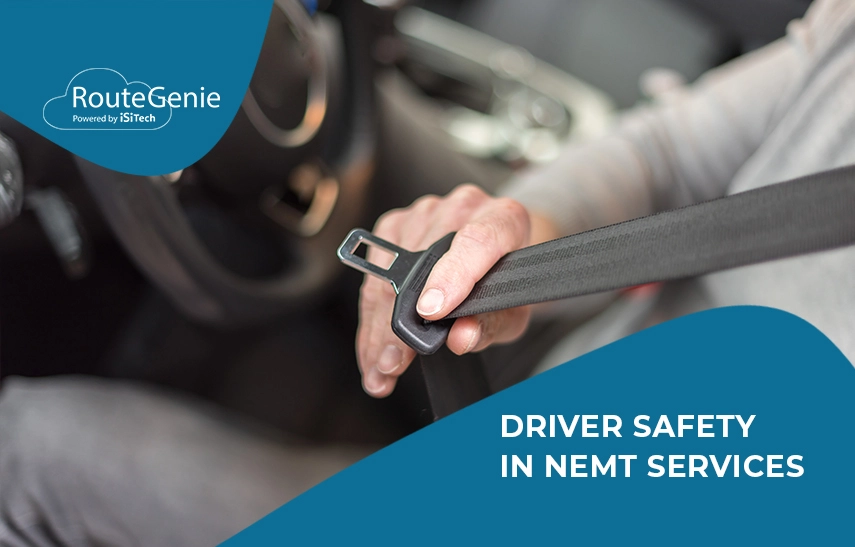Driver Safety in NEMT Services

Driver safety is a constant concern in the non-emergency medical transport industry. After all, these professionals are responsible for the health and safety of their passengers—largely vulnerable patients on their way to and from medical appointments.
Drivers are also responsible for ensuring their vehicles are well-maintained and will complete all the trips they are assigned.
But who can ensure the safety and security of the drivers?
Transport providers must deploy robust strategies to protect their drivers. This can be done through advanced technology and a work culture that prioritizes safety in the workplace.
Let’s look at the different ways NEMT providers can protect their drivers, which leads to safer trips and satisfied customers.
Contents:
- The Importance of Driver Safety in NEMT Services
- Common Risks Faced by NEMT Drivers
- Best Practices for NEMT Driver Safety
- Preparing for Emergencies in NEMT Services
- Drivers Make NEMT Services Safe
The Importance of Driver Safety in NEMT Services
Safety is a must in any transport service, especially in the NEMT industry. So much of this relies on the skill and experience of the individual driver.
And NEMT drivers have the unique responsibility of transporting passengers who are medically compromised, elderly, and/or disabled. Safely transporting vulnerable patients requires skill, dedication, and attention to detail. But, perhaps most importantly, drivers must have extensive resources that NEMT managers and owners must provide.
Of course, NEMT providers must hire people who are skilled in driving. They must also know how to provide basic first aid training and medical assistance in case of emergencies. Along with this, NEMT drivers must have some knowledge of vehicle maintenance and defensive driving techniques.
NEMT operators also have an ethical and legal obligation to ensure that their drivers receive the proper NEMT driver training and licenses. After all, the driver is the first line of support passengers will have in case of an accident.
Of course, this is all in the best interest of the NEMT provider. A skilled driver at the helm ensures completed trips, good feedback from passengers, and repeat appointments.
Common Risks Faced by NEMT Drivers
Drivers in the industry make multiple trips in one day. They transport patients with varying health issues. They drive vehicles on roads that are subject to weather conditions and traffic issues.
With each trip, there is potential for injuries, accidents, and other health risks. Being an NEMT driver is a job that requires skill and knowledge in basic medical training and the use of certain equipment.
Most NEMT companies provide safety nets, such as medical compensation and health insurance for their drivers. However, they still face considerable risks that must be mitigated:
Traffic Accidents
Road accidents are a risk that drivers face. The bigger the fleet, the more likely an NEMT company will face this issue.
This is why it is vital for dispatchers and drivers to review the best and safest routes for their passengers.
Vehicle Breakdowns
Even with regular maintenance, vehicles can still break down due to weather, road conditions, or regular wear. This delays trips and may cause patients to miss their appointments or treatments.
Vehicle breakdowns in the wrong place can also cause accidents that could hurt drivers and passengers.
Patient Safety
Drivers must know how to assist patients with special needs or mobility issues. They need proper training, or else they will not be able to help their passengers.
Exposure to Infectious Diseases
Drivers can be exposed to infectious diseases from their passengers.
Additionally, passengers with weak immune systems may be compromised due to exposure to bacteria or viruses.
Fatigue
Driving can be a stressful and tiring job. NEMT drivers may feel fatigued after a long day with multiple trips. This can impair their skills if they work long hours, increasing the risk of accidents on the road.
Workplace Violence
NEMT drivers may face difficult passengers. The patient could be experiencing mental health issues and may strike out at a driver. A simple disagreement during the trip may escalate into a fight.
Careless drivers may not be on their best behavior. They may come into work under the influence of alcohol or other substances. They could be aggressive to their passengers or other drivers.
Best Practices for NEMT Driver Safety
 NEMT operators must establish strict safety protocols and use equipment to ensure their drivers work in a safe environment. Management teams are responsible for providing the support drivers need.
NEMT operators must establish strict safety protocols and use equipment to ensure their drivers work in a safe environment. Management teams are responsible for providing the support drivers need.
These include the following NEMT driver safety tips:
Driver Safety Training
Providing adequate training to NEMT drivers will give them the ability to provide passenger assistance. Vehicle maintenance and defensive driving are also essential skills to develop.
NEMT providers could also arrange for first aid and medical assistance training programs. Even administrative staff could benefit from these.
The Latest Communication and GPS Technology
Drivers should know how to use the latest communication and tracking technology. NEMT software has GPS tracking and communication systems so drivers can use mobile apps to connect with their support teams.
For example, RouteGenie has advanced features that leverage these technologies to help drivers and operators. Passengers and drivers can use dedicated apps to ensure they are at the right place and time.
RouteGenie also has fleet maintenance and personnel management features that help track licensing, permits, and maintenance schedules. It can also automate vehicle checkups before and after each trip.
Driver Monitoring
NEMT providers can also use NEMT software for real-time monitoring of drivers and vehicles. They can track their location and, with OBD device integration into vehicles, assess their real-time performance to see if the drivers follow proper safety measures.
This system will send updates on the condition of the vehicle. Dispatchers will be notified if the driver needs mechanical or technical support. Management teams can also use the system to review the driver’s speed, acceleration, and fuel use.
Risk Assessment
Drivers must be trained for proper risk assessment for their vehicles before and after a trip. This will help them identify potential dangers before they get on the road. They can take precautions to ensure the journey will be safe for passengers.
Safe Workplace Culture
NEMT operators must build an open and safe workplace culture. It will encourage drivers, dispatchers, administrative staff, and other employees to be honest about their work. This transparency will make it easier to maintain safety in the workplace.
Passengers also benefit from this. A positive and light atmosphere during a trip can keep them calm and more agreeable throughout the journey.
Preparing for Emergencies in NEMT Services
 There are many ways for NEMT providers to prepare their drivers and personnel for any kind of emergency.
There are many ways for NEMT providers to prepare their drivers and personnel for any kind of emergency.
Here are some measures that management teams should put in place:
Emergency Response Plan
A detailed emergency response plan outlines everything drivers and other personnel must do in an emergency.
For example, if a driver gets into a road accident, NEMT dispatchers must:
- Contact relevant personnel
- Track and identify the location of the vehicle
- Provide medical support if needed
Staff Training
These training programs should include basic first aid, CPR, and how to use NEMT software to call for support.
Drivers and staff should be familiar with all the steps in the emergency response plan. They should know their duties and corresponding actions in an emergency.
Regular Fleet Maintenance
All vehicles must be inspected regularly to ensure they are in good condition. The engine, mileage, and fuel use should be monitored daily.
All emergency equipment in the facility should also be checked and maintained.
NEMT Software
NEMT software can be used to monitor the location of a vehicle and driver in real-time. It can also serve as a communication tool for passengers, drivers, and the dispatchers.
Passenger Information
NEMT providers must establish a system to review all passenger information. This ensures that they are picking up the right passenger and can provide the needed assistance in an emergency.
It also ensures that the driver is picking up the right person. Passenger information checks should include IDs, emergency contacts, medical history, and specialized care they may need.
Regular Testing, Updates, and Reviews
NEMT drivers and personnel must undergo regular testing and performance reviews. This ensures their knowledge of all relevant medical emergency response plans is up-to-date. They must also maintain the proper NEMT certification.
Testing and training ensure they can provide the best possible service for passengers. All NEMT personnel must be prepared to respond to an emergency.
Drivers Make NEMT Services Safe
Drivers, operators, and personnel are all integral to the NEMT industry. But it is the driver that deals directly with passengers and patients. If there is an emergency on the road, they must provide needed care.
However, drivers need to feel safe too. NEMT providers, owners, and management teams must observe these best practices. They must be ready for emergencies and instances when drivers need their aid. Even a simple mechanical breakdown on the road can still pose a danger to drivers, passengers, and everyone around them.
If you want to explore the best ways to protect your drivers, explore using NEMT software like RouteGenie. This software has all the necessary tools and advanced features that providers need to support their drivers and their fleet.
About the author
An experienced content writer, Keren Dinkin’s forte is writing well-informed medical transportation, healthcare accounting, and related articles. Her work is backed by months of intensive research and pays meticulous attention to details. In addition to being a writer, she also dons the hat of a content strategist.
The author assumes no responsibility or liability for any errors or omissions in the content of this site. The information contained in this site is provided on an "as is" basis with no guarantees of completeness, accuracy, usefulness or timeliness.